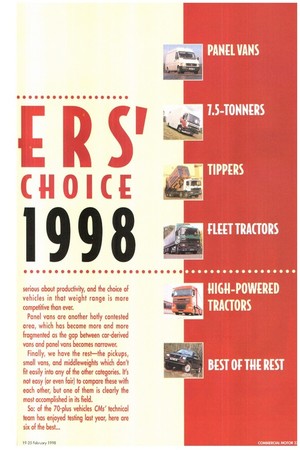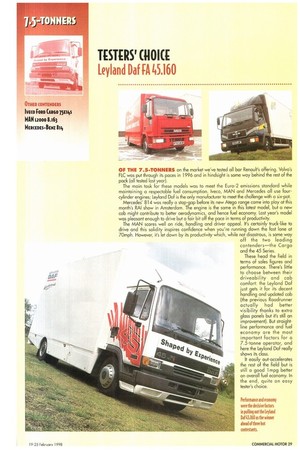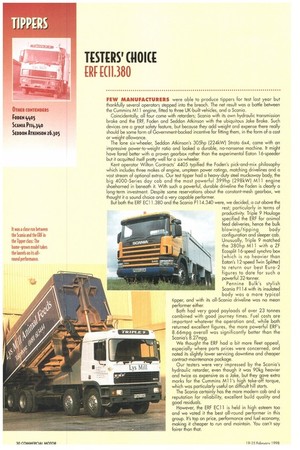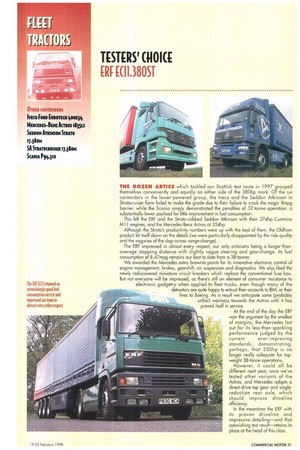AS EVER, CM drove the widest possible range of commercial
Page 28

Page 29

Page 30

Page 31

Page 32

Page 33

Page 34

Page 35

If you've noticed an error in this article please click here to report it so we can fix it.
vehicles during 1997, from car-derived "hatchvans" such as the Ford Fiesta to the most powerful trucks on the road, including MAN's mighty 19.603. Here we've taken another look at those we performed full tests on, and compared their results with a cool eye to select our Testers' Choice in each class.
As far as Commercial Motor's test team was concerned, 1997 was the Year of the Artic: we finally got our hands on a good range of Euro-2 tractive units, and recorded some of the best results we've ever seen round the CM Scottish Route.
The figures prove that tighter emissions regulations need not mean worse productivity: more torquey and responsive engines are delivering better fuel economy and good average speeds. But the biggest surprise of all was that a modern, mechanically fuel-injected diesel can be just as efficient as an electronically controlled unit.
Slightly lower down the weight range we tested a number of tippers at 26 and 32 tonnes, and marvelled at the massive power-to-weight ratios that are being specified now: evidently speed is of the essence for the modern tipperman.
Operators of 7.5-tonners are just as
serious about productivity, and the choice of vehicles in that weight range is more competitive than ever.
Panel vans are another hotly contested area, which has become more and more fragmented as the gap between car-derived vans and panel vans becomes narrower.
Finally, we have the rest—the pickups, small vans, and middleweights which don't fit easily into any of the other categories. It's not easy (or even fair) to compare these with each other, but one of them is clearly the most accomplished in its field.
So: of the 70-plus vehicles CMs' technical team has enjoyed testing last year, here are six of the best...
TESTERS' CHOICE
Volkswagen n.35 TDI
CITROEN RELAY 1800 2.5TDI FORD TRANSIT 100 ISU/U NKR IVECO DAILY 35.10 MERCEDES-BENZ VITO 108D VOLKSWAGEN TRANSPORTER TDI
THE PANEL VAN tests of '97 showed that the best are getting better while the worst are doing a fair job of staying afloat, if only by treading water.
New models from Volkswagen and Mercedes came our way; so did the Isuzu NKR 3.5-tonner which was new to the UK market. It's not really a panel van but it operates in the same market so we've included it anyway. The Japanese firm's N-Series may be the best selling truck in the world, but we doubt it'll make any serious dents in the UK market. Its main strength is load volume but ultimately it's let down by a cramped cab and poor driveability. The two at the bottom of the pile are the Iveco Daily and the Ford Transit. Iveco's latest Daily comes with disc brakes all-round, a revised engine and a rather deafening colour scheme! The brakes are seriously good, the engine more refined and the colours are truly odious but it's still well behind in terms of The Transit's improvements are limited security. It's still the front runner in terms loud diesels can make the going irksome. Mercedes entered the compact panel v modern refinement.
to power steering as standard and souped up of creature comforts, but the low-powered and an market with the Vito 108D, which has a lot to commend it. Productivity is strong and it's pleasant to drive. Unfortunately, it doesn't represent any significant improvement over VW's Transporter. This year we're concentrating on the capacious 3.5-tonners and of these Ws a thirdumpire job between the Citroen and the VW.
Citroen's new directinjection diesel is a thoroughbred and, in terms of pure productivity, makes the Sevel the van of choice.
Ultimately, however, the LT35 is almost as productive; will keep its value well; has a decent cab; and refined driveability. Just enough, in fact, to win this year's panel van category.
TESTERS' WOKE
Leyland Daf fA 45.160
OTHER CONTENDERS IVECO FORD CARGO BOO MAN iz000 8.163 MERCEDES-BENZ But
OF THE 7.5-TONNERS on the market we've tested all bar Renault's offering. Volvo's FLC was put through its paces in 1996 and in hindsight is some way behind the rest of the pack (all tested last year). The main task for these models was to meet the Euro-2 emissions standard while maintaining a respectable fuel consumption. lveco, MAN and Mercedes all use fourcylinder engines; Leyland Dal is the only manufacturer to meet the challenge with a six-pot. Mercedes' 814 was really a stop-gap before its new Atego range came into play at this month's RAI show in Amsterdam. The engine is the some in this latest model, but a new cab might contribute to better aerodynamics, and hence fuel economy. Last year's model was pleasant enough to drive but a fair bit off the pace in terms of productivity. The MAN scores well on ride, handling and driver appeal. It's certainly truck-like to drive and this solidity inspires confidence when you're running down the fast lane at 70mph. However, it's let down by its productivity which, while not disastrous, is some way off the two leading contenders—the Cargo and the 45 Series.
These head the field in terms of sales figures and performance. There's little to choose between their driveability and cab comfort: the Leyland Daf just gets it for its decent handling and updated cab (the previous Roadrunner actually had better visibility thanks to extra glass panels but it's still an improvement). But straightline performance and fuel economy are the most important factors for a 7.5-tonne operator, and here the Leyland Daf redly shows its class.
It easily out-accelerates the rest of the field but is still a good lmpg better on overall fuel economy. In the end, quite an easy tester's choice.
TESTERS' GIME
{01.380
OTHER CONTENDERS tODEN itito5 SONIA P114.340 SEDDON ATKINSON 26.305
FEW MANUFACTURERS were able to produce tippers for test last year but thankfully several operators stepped into the breach. The net result was a battle between the Cummins Ml] engine, fitted to three UK-built vehicles, and a Scenic]. Coincidentally, all four came with retarders; Scania with its own hydraulic transmission brake and the ERF, Foden and Seddon Atkinson with the ubiquitous Jake Brake. Such devices are a great safety feature, but because they add weight and expense there really should be some form of Government-backed incentive for fitting them, in the form of a cost or weight allowance.
The lone six-wheeler, Seddon Atkinson's 305hp (224kW) Strata 6x4, came with an impressive power-to-weight ratio and looked a durable, no-nonsense machine. It might have fared better with a proven gearbox rather than the experimental Eaton 16-speeder but it acquitted itself pretty well for a six-wheeler. Kent operator Wilton Contracts' 4405 typified the Foden's pick-and-mix philosophy which includes three makes of engine, umpteen power ratings, matching drivelines and a vast stream of optional extras. Our test tipper had a heavy-duly steel muckaway body, the big 4000-Series day cab and the most powerful 399hp (298kW) Ml] engine shoehorned in beneath it. With such a powerful, durable driveline the Foden is clearly a long-term investment. Despite some reservations about the constant-mesh gearbox, we thought it a sound choice and a very capable performer. But both the ERF EC11.380 and the Scania P114.340 were, we decided, a cut above the rest; particularly in terms of productivity. Triple 9 Haulage specified the ERF for animal feed deliveries, hence the bulk blowing/tipping body configuration and sleeper cab. Unusually, Triple 9 matched the 380hp MI 1 with a ZF Ecosplit 16-speed synchro box (which is no heavier than Eaton's 12-speed Twin Splitter) to return our best Euro-2 figures to date for such a powerful 32-tanner. Pennine Bulk's stylish Scania PI 14 with its insulated body was a more typical tipper, and with its all-Scania driveline was no mean performer either. Both had very good payloads of over 23 tonnes combined with good journey times. Fuel costs are important whatever the operation and, while both returned excellent figures, the more powerful ERF's 8.66mpg overall was significantly better than the Scania's 8.27mpg. We thought the ERF had a bit more fleet appeal, especially where parts prices were concerned, and noted its slightly lower servicing downtime and cheaper contract-maintenance package. Our testers were very impressed by the Scania's hydraulic retarder, even though it was 90kg heavier and twice as expensive as a Jake, but they gave extra marks for the Cummins MI I 's high take-off torque, which was particularly useful on difficult hill starts. The Sarnia certainly has the more modern cab and a reputation for reliability, excellent build quality and good residuals.
However, the ERF EC1 1 is held in high esteem too and we voted it the best all-round pertormer in this group. It's top on price, performance and fuel economy, making it cheaper to run and maintain. You can't say fairer than that.
TESTERS CHOICE [RI [(11.3805T
IVECO FORD EUROTECH400E34
..... r.BENZ AcTRosi83513 SEDDON ATKINSON STRATO q.38ow SA STRATOCRUISER 17.380W SC.ANIA P911.310
THE DOZEN ARTICS which tackled our Scottish test route in 1997 grouped themselves conveniently and equally on either side of the 380hp mark. Of the six contenders in the lower-powered group, the Iveco and the Seddon Atkinson in Stratocruiser form failed to make the grade due to their failure to crack the magic 8mpg barrier, while the Scania simply demonstrated the penalties of 32-tonne operation: a substantially lower payload for little improvement in fuel consumption. This left the ERF and the Strato-cabbed Seddon Atkinson with their 374hp Cummins M11 engines, and the Mercedes-Benz Actros at 354hp. Although the Strata's productivity numbers were up with the best of them, the Oldham product let itself down on the details (we were particularly disappointed by the ride quality and the vagaries of the slap-across range-change). The ERF impressed in almost every respect, our only criticisms being a longer-thanaverage stopping distance with slightly vague steering and gearchange. Its fuel consumption ot 8.47mpg remains our best to date from a 38-tonner.
We awarded the Mercedes extra brownie points for its innovative electronic control of engine management, brakes, gearshift, air suspension and diagnostics. We also liked the newly rediscovered miniature circuit breakers which replace the conventional fuse box. But not everyone will be impressed, as there's still an element of consumer resistance to electronic gadgetry when applied to fleet trucks, even though many of the detractors are quite happy to entrust their accounts to IBM, or their lives to Boeing. As a result we anticipate some (probably unfair) wariness towards the Actros until it has proved itself in service.
At the end of the day the ERF won the argument by the smallest of margins; the Mercedes lost out for its less-than-sparkling performance judged by the current ever-improving standards; demonstrating, perhaps, that 350hp is no longer really adequate for topweight 38-tonne operations.
However, it could all be different next year, once we've tested other variants of the Actros, and Mercedes adopts a direct-drive top gear and singlereduction rear axle, which should improve driveline efficiency.
In the meantime the ERF with its proven driveline and impressive detailing—and that astonishing test result—retains its place at the head of this class.
TESTERS' CHOICE
Leyland Daf 95XF 480
OTHER CONTEND+ FODEN kitos 6xz RENAULT PREMIUM PRIVILEGE 385 SCAN IA RI24-400 IT'S EITHER FAMINE or feast where 500hp-plus attics are concerned. In 1996 we were snowed under with them, but last year there wasn't a single one to be found for our Scottish test hit list. Instead we found ourselves driving a succession of big-cab rigs, but with much more sensible engine outputs. Foden's Si 06M4 with its big, bold XL cab was impressively large and quiet while the 400hp Cummins Ml] -led clriveline beneath it performed quite efficiently. As far as our test went, however, the 4x2's lifting mid-axle was simply too much of a handicap against some excellent competition. Out of the blue came Renault's Premium Privilege 385, aimed straight at the longdistance haulage sector. We could hardly fault it in important areas like payload, average speed and ride, but we did jib at the lack of a cruise control. It took a while to get acclimatised to Renault's TBV semi-automatic gear selection so the jury's still out on that, but Renault's cab was extremely well finished and impressively quiet.
The only customer's artic in this group turned out to be Eddie Stobart's Scania R124, and what a treat it was to spend nights out with the 400hp Nicola (anorak wearing enthusiasts will know what we mean!).
Wether static or on the move, Scania's twin-bunk R-cab is a real driver's treat. Out on the open road it's impressively fast and frugal, whatever the terrain. Managers might appreciate its performance but they'll be less impressed by payload, which just ain't its best feature, nor by its retail price, which is staggering. We were unanimous in choosing the Daf FT 95XF as our pick of the pride. This ultraquiet Space Cabbed 480hp machine with Daf Jake brake and traditional driveline really is the bee's knees.
OK, that big cab bumped up the dead weight and retail price, but knock off some of the over-indulgences and the package looks something like.
To its credit the reworked 12.6-litre Euro-2 engine with its 24-valve head delivered superb economy, amazingly quick journey times and class-beating productivity. Such is its performance and image lhat it's hard to decide whether to call the 95XF a fleet tractor or a high-spec fancy dancer. Whatever its label,
it's our top tractor choice.
TESTERS' CHOICE Mitsubishi L200 pickup
FORD FIESTA 351.8D VAN
MAN 18124 fl-CAB)
MAN 18,261, (14-CAB) TATA LOADBETA TD DOUBLE (AB
AFTER WE'VE GROUPED most of the vehicles we test each year there are always a few left over which don't fit into the regular categories. In 1997 these included Ford's latest hatchvan, Iwo rather different pickups and a pair of MAN M2000 17-tonners with contrasting cabs and engines.
These were the first Euro-2 17-tonners we've tested, and each returned fuel consumption figures near the best that had gone before. Choosing between them wasn't easy: the more powerful 18.264 was fitted with the M-type cab, while the 18.224 had the smaller L-cab. Its payload was marginally better, and it cost £5,000 less, but it was rather slower.
Only a clued-up fleet manager can make the choice: how about an 1-cabbed 18.264?
The little Fiesta 35 is a solidly built hatchback with an excellent interior and, not surprisingly, the potential for 50mpg fuel economy. It did everything well, but in a searingly competitive market it didn't stand apart. One vehicle that definitely does stand apart is the Tata Loadbeta: a two-wheel-drive pickup which looks like a 4x4 and is built like a brick outhouse. The latest turbo-diesel version has a crew-cab made For four and costs less than 212,000 including VAT. It has plenty in its favour, but we think it also has Far too much against it—ride, handling and braking were all poor, and safety features are few. Not our favourite vehicle.
On the other hand, we all liked Mitsubishi's L200 4x4 pickup, and the latest, charge-cooled variant is better than ever. This tough, handsome vehicle is powerful on the road and very competent off it. The price is competitive, the payload is best in its class, and it's all topped off with a three-year, 100,000-mile warranty. The Mitsubishi is such a competent package that there's no doubt it deserves a Testers' Choice award all to itself.




































































































